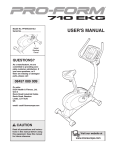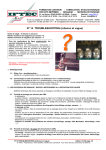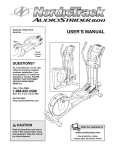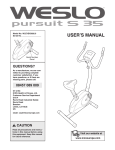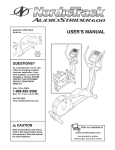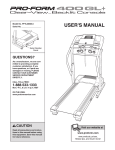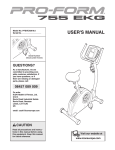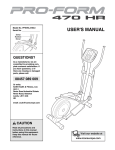Download ProForm EKG 831.297890 User`s manual
Transcript
Model No. PFEVEX2916.0 Serial No. USER'S MANUAL Serial Number Decal QUESTIONS? As a manufacturer, we are committed to providing complete customer satisfaction. If you have questions, or if there are missing or damaged parts, please call: 08457 089 009 Or write: ICON Health & Fitness, Ltd. Unit 4 Revie Road Industrial Estate Revie Road, Beeston Leeds, LS11 8JG UK email: [email protected] CAUTION Read all precautions and instructions in this manual before using this equipment. Keep this manual for future reference. Visit our website at www.iconeurope.com TABLE OF CONTENTS IMPORTANT PRECAUTIONS . . . . . . . . . . . . . . . . . . . . . . . . . . . . . . . . . . . . . . . . . . . . . . . . . . . . . . . . . . . . . . . .2 BEFORE YOU BEGIN . . . . . . . . . . . . . . . . . . . . . . . . . . . . . . . . . . . . . . . . . . . . . . . . . . . . . . . . . . . . . . . . . . . . . .3 ASSEMBLY . . . . . . . . . . . . . . . . . . . . . . . . . . . . . . . . . . . . . . . . . . . . . . . . . . . . . . . . . . . . . . . . . . . . . . . . . . . . . . .4 HOW TO OPERATE THE EXERCISE CYCLE . . . . . . . . . . . . . . . . . . . . . . . . . . . . . . . . . . . . . . . . . . . . . . . . . . . .8 MAINTENANCE AND TROUBLESHOOTING . . . . . . . . . . . . . . . . . . . . . . . . . . . . . . . . . . . . . . . . . . . . . . . . . . .20 CONDITIONING GUIDELINES . . . . . . . . . . . . . . . . . . . . . . . . . . . . . . . . . . . . . . . . . . . . . . . . . . . . . . . . . . . . . . .21 PART LIST . . . . . . . . . . . . . . . . . . . . . . . . . . . . . . . . . . . . . . . . . . . . . . . . . . . . . . . . . . . . . . . . . . . . . . . . . . . . . .22 EXPLODED DRAWING . . . . . . . . . . . . . . . . . . . . . . . . . . . . . . . . . . . . . . . . . . . . . . . . . . . . . . . . . . . . . . . . . . . .23 ORDERING REPLACEMENT PARTS . . . . . . . . . . . . . . . . . . . . . . . . . . . . . . . . . . . . . . . . . . . . . . . . . .Back Cover IMPORTANT PRECAUTIONS WARNING: To reduce the risk of serious injury, read the following important precautions before using the exercise cycle. 8. Wear appropriate clothes while exercising; do not wear loose clothes that could become caught on the exercise cycle. Always wear athletic shoes for foot protection. 1. Read all instructions in this manual and all warnings on the exercise cycle before using the exercise cycle. Use the exercise cycle only as described in this manual. 9. The pulse sensor is not a medical device. Various factors, including the user's movement, may affect the accuracy of heart rate readings. The pulse sensor is intended only as an exercise aid in determining heart rate trends in general. 2. It is the responsibility of the owner to ensure that all users of the exercise cycle are adequately informed of all precautions. 3. The exercise cycle is intended for home use only. Do not use the exercise cycle in a commercial, rental, or institutional setting. 10. Always keep your back straight while using the exercise cycle; do not arch your back. 4. Keep the exercise cycle indoors, away from moisture and dust. Place the exercise cycle on a level surface, with a mat beneath it to protect the floor. Make sure that there is enough clearance around the exercise cycle to mount, dismount, and use it. 11. If you feel pain or dizziness while exercising, stop immediately and cool down. 12. The exercise cycle does not have a freewheel; the pedals will continue to move until the flywheel stops. 5. Inspect and properly tighten all parts regularly. Replace any worn parts immediately. 13. The warning decals shown on page 3 have been placed on the exercise cycle. If a decal is missing or illegible, call the telephone number on the front cover of this manual and request a free replacement decal. Apply the decal in the location shown. 6. Keep children under the age of 12 and pets away from the exercise cycle at all times. 7. The exercise cycle should not be used by persons weighing more than 113 kg (250 lbs). WARNING: Before beginning this or any exercise program, consult your physician. This is especially important for persons over the age of 35 or persons with pre-existing health problems. Read all instructions before using. ICON assumes no responsibility for personal injury or property damage sustained by or through the use of this product. 2 BEFORE YOU BEGIN Congratulations for selecting the new PROFORM® 748 EKG exercise cycle. Cycling is one of the most effective exercises for increasing cardiovascular fitness, building endurance, and toning the entire body. The 748 EKG exercise cycle offers a selection of features designed to let you enjoy this healthful exercise in the convenience and privacy of your home. after reading this manual, see the front cover of this manual. To help us assist you, please note the product model number and serial number before contacting us. The model number is PFEVEX2916.0. The serial number can be found on a decal attached to the exercise cycle (see the front cover of this manual). Before reading further, please familiarize yourself with the parts that are labeled in the drawing below. For your benefit, read this manual carefully before you use the exercise cycle. If you have questions FRONT Handlebar Console 246726 246725 Pulse Sensor Adjustment Handle Water Bottle Holder* 219979 Prt Seat Seat Knob Seat Post Adjustment Knob • Not for therapeutic use. • Nicht für therapeutisch Gebrauch. 151249Wheel REAR Pedal/Strap Leveling Foot *No water bottle is included ! 3 250085 ASSEMBLY Assembly requires two persons. Place all parts of the exercise cycle in a cleared area and remove the packing materials. Do not dispose of the packing materials until assembly is completed. Assembly requires the included tools and your own adjustable wrench screwdriver . and Phillips Use the part drawings below to identify the small parts used in assembly. The number in parenthesis below each drawing refers to the key number of the part, from the PART LIST on page 22. The second number refers to the quantity needed for assembly. Note: Some small parts may have been preattached for shipping. If a part is not in the parts bag, check to see if it has been preattached. M4 x 15mm Screw (15)–2 M4 x 15mm Screw (40)–4 M6 x 8mm Screw (51)–2 M10 x 20mm Button Screw (35)–3 M8 Nylon Locknut (37)–4 M8 Split Washer (36)–4 M10 Split Washer (34)–7 M10 x 73mm Button Screw (33)–4 1. Identify the Front Stabilizer (2), which has round wheels. While another person lifts the front of the Frame (1), attach the Front Stabilizer to the Frame with two M10 x 73mm Button Screws (33) and two M10 Split Washers (34). 1 1 2 34 33 4 34 2. While another person lifts the rear of the Frame (1), attach the Rear Stabilizer (14) to the Frame with two M10 x 73mm Button Screws (33) and two M10 Split Washers (34). 2 14 1 34 34 3. While another person holds the Upright (3) near the Frame (1), connect the Upper Wire Harness (32) to the Lower Wire Harness (31). 3 Gently pull the upper end of the Upper Wire Harness (32) to remove the slack, and slide the Upright (3) onto the Frame (1). Be careful to avoid pinching the Wire Harnesses. Attach the Upright with three M10 x 20mm Button Screws (35) and three M10 Split Washers (34). Be careful to avoid pinching the Wire Harnesses (31, 32) 3 35 34 34 1 4. Attach the Water Bottle Holder (29) to the Upright (3) with two M4 x 15mm Screws (15). 4 15 29 5 33 3 35 32 31 5. The Console (6) requires four “AA” batteries; alkaline batteries are recommended. Press the tab on the battery cover and remove the battery cover. Insert four batteries into the console; make sure that the batteries are oriented as shown by the diagram inside the battery compartment. Then, reattach the battery cover. 5 Batteries Battery Cover Note: The Console (6) can be operated with an optional power supply instead of batteries. To purchase a power supply, call the telephone number on the front cover of this manual. Plug one end of the power supply into the jack on the console. Plug the other end of the power supply into an appropriate outlet that is properly installed in accordance with all local codes and ordinances. 6. While another person holds the Console (6) near the Upright (3), connect the console wire harness to the Upper Wire Harness (32). 6 6 Insert the excess Upper Wire Harness (32) downward into the Upright (3). Attach the Console (6) to the Upright with four M4 x 15mm Screws (40). Be careful to avoid pinching the wires. Console Wire Harness 3 40 32 40 7. Attach the Handlebar (47) to the Upright (3) with the Upright Clamp (45) and the Adjustment Handle (46). Note: The Adjustment Handle may work like a spanner. Turn the handle clockwise, push it toward the Handlebar, turn it counterclockwise, pull it away from the Handlebar, and then turn it clockwise again. Be careful to avoid pinching the wires 7 3 6 6 45 46 47 8. Orient the Seat Post (5) as shown. Loosen the Adjustment Knob (11) a few turns, pull the Adjustment Knob outward, and insert the Seat Post into the Frame (1). Move the Seat Post upward or downward to the desired position, and then release the Adjustment Knob into one of the adjustment holes in the Seat Post. Then, tighten the Adjustment Knob a few turns. Make sure that the Adjustment Knob is engaged in an adjustment hole. 8 51 5 Attach an M6 x 8mm Screw (51) to the front of the Seat Post (5). 1 9. Orient the Seat (12) and the Seat Carriage (26) as shown. Attach the Seat to the Seat Carriage with four M8 Nylon Locknuts (37) and four M8 Split Washers (36). Note: The Nylon Locknuts and Split Washers may be preattached to the underside of the Seat. 11 9 12 51 Slide the Seat Carriage (26) onto the Seat Post (5) and move the Seat Carriage forward or backward to the desired position. Then, tighten the Seat Knob (52) into the Seat Carriage. 5 52 26 Attach an M6 x 8mm Screw (51) to the rear of the Seat Post (5). 36 37 10.Identify the Left Pedal (24), which is marked with an “L.” Using an adjustable wrench, firmly tighten the Left Pedal counterclockwise into the Left Crank Arm (42). Tighten the Right Pedal (not shown) clockwise into the Right Crank Arm (not shown). Important: Tighten both Pedals as firmly as possible. After using the exercise cycle for one week, retighten the Pedals. For best performance, keep the Pedals tightened. 10 Adjust the strap on the Left Pedal (24) to the desired position, and press the end of the strap onto the tab on the side of the Left Pedal. Adjust the strap on the Right Pedal (not shown) in the same way. Strap Tab 24 42 11. Make sure that all parts are properly tightened before you use the exercise cycle. Note: After assembly is completed, some extra parts may be left over. Place a mat beneath the exercise cycle to protect the floor. 7 HOW TO OPERATE THE EXERCISE CYCLE HOW TO ADJUST THE HEIGHT OF THE SEAT HOW TO ADJUST THE HANDLEBAR For effective exercise, the seat should be at the proper height. As Seat you pedal, there should be a slight Adjustment bend in your knees Knob when the pedals Seat are in the lowest Post position. To adjust the seat, first turn the adjustment knob counterclockwise several turns to loosen it. Next, pull the knob, slide the seat post upward or downward to the desired position, and then release the knob. Move the seat post upward or downward slightly to make sure that the knob is engaged in one of the adjustment holes in the seat post. Then, turn the knob clockwise to tighten it. To adjust the handlebar, first turn the indicated adjustment handle counterclockwise to loosen it. Note: The adjustment handle may work like a spanner. Turn the handle Handle counterclockwise, pull it away from the handlebar, turn it clockwise, push it toward the handlebar, and then turn it counterclockwise again. Repeat until the handlebar is loose. Move the handlebar upward or downward to the desired position and then retighten the handle. HOW TO ADJUST THE PEDAL STRAPS To adjust the pedal straps, first pull the ends of the pedal straps off the tabs on the pedals. Adjust the pedal straps to the desired position, and then press the ends of the pedal straps onto the tabs. HOW TO ADJUST THE LATERAL POSITION OF THE SEAT To adjust the lateral position of the seat, first loosen the seat knob a few turns. Then, move the seat forward or backward to the desired position, and firmly tighten the seat knob. Seat Seat Knob 8 Pedal Strap CONSOLE DIAGRAM FEATURES OF THE CONSOLE cycle to your home stereo, portable stereo, computer, or VCR and play special iFIT.com CD and video programs (iFIT.com CDs and videocassettes are available separately). iFIT.com CD and video programs automatically control the resistance of the pedals and prompt you to vary your pace as a personal trainer coaches you through every step of your workout. High-energy music provides added motivation. To purchase iFIT.com CDs and videocassettes, visit our website at www.iconeurope.com. The console offers a selection of features designed to make your workouts more effective. When you use the manual mode of the console, you can change the resistance of the pedals with the touch of a button. As you exercise, the console will provide continuous exercise feedback. You can even monitor your heart rate using the handgrip pulse sensor or the optional chest pulse sensor. Note: For information about the optional chest pulse sensor, see page 19. With the exercise cycle connected to your computer, The console features six smart programs that automati- you can also go to our website at www.iFIT.com and EBPE2916 access programs directly from the Internet. Explore cally change the resistance of the pedals and prompt PFEVEX2916.0 you to vary your pedaling pace while guiding you www.iFIT.com for more information. through an effective workout. To use the manual mode of the console, follow the The console also offers two heart rate programs that steps beginning on page 10. To use a smart program, automatically control the resistance of the pedals and see page 12. To use a heart rate program, see page prompt you to maintain a constant pedaling pace to 13. To use an iFIT.com CD or video program, see keep your heart rate near target heart rate settings dur- page 17. To use a program directly from our webing your workouts. site, see page 18. In addition, the console also features iFIT.com interactive technology. Having iFIT.com interactive technology is like having a personal trainer in your home. Using the included audio cable, you can connect the exercise Before using the console, make sure that batteries are installed (see assembly step 5 on page 6). If there is a sheet of clear plastic on the display, remove the plastic. 9 The second section of the display will show your pedaling pace, in miles or kilometers per hour. HOW TO USE THE MANUAL MODE 1 2 3 4 Turn on the console. To turn on the console, press any button or begin pedaling. The display will light and the console will be ready for use. The third section of the display will show the approximate number of calories you have burned and the resistance level of the pedals. The display will change modes every few seconds. The display will also show your heart rate when you use the handgrip pulse sensor or the optional chest pulse sensor (see step 5 on page 11). Select the manual mode. Each time you turn on the console, the manual mode will be selected. If you have selected a program, reselect the manual mode by pressing any of the Program buttons repeatedly until zeroes appear in the display. The last section of the display will show a track representing 1/4 mile. As you exercise, indicators will appear in succession around the track until the entire track appears. The track will then disappear and the indicators will again begin to appear in succession Begin pedaling and change the resistance of the pedals as desired. As you pedal, change the resistance of the pedals by pressing the Increase and Decrease buttons. There are ten resistance levels. Note: After you press the buttons, it will take a moment for the pedals to reach the selected resistance level. Note: The console can show speed and distance in either miles of kilometers. The letters MPH or Km/H will appear in the display to indicate which unit of measurement is selected. To change the unit of measurement, press and hold down the Program Select button for a few seconds. An “E” for English mile or an “M” for metric kilometers will appear in the display. Press the Increase button to select the desired unit of measurement. Then, press the Program Select button. Note: When you replace the batteries, it may be necessary to reselect the unit of measurement. Follow your progress with the display. The upper section of the display will show the elapsed time and the distance, in miles or kilometers, that you have pedaled. The display will change modes every few seconds. Note: When you select a smart program the display will show the time remaining in the program instead of the elapsed time. 10 5 Measure your heart rate if desired. You can measure you heart rate using either the handgrip pulse sensor or the optional chest pulse sensor (see page 19 for information about the optional chest pulse sensor). Note: If you hold the handgrip pulse sensor and wear the chest pulse sensor at the same time, the console will not display your heart rate accurately. If there are sheets of clear plastic on the metal contacts on the handgrip pulse sensor, remove the plastic. Next, hold the handgrip pulse sensor with your palms resting on the metal 6 Contacts 11 contacts. Avoid moving your hands or gripping the contacts too tightly. When your pulse is detected, a heart-shaped symbol will flash in the display each time your heart beats and then your heart rate will be shown. For the most accurate heart rate reading, hold the contacts for at least 15 seconds. When you are finished exercising, the console will turn off automatically. If the pedals do not move for a few seconds, the time will begin to flash in the display and the console will pause. If the pedals do not move for a few minutes and no buttons are pressed, the console will turn off and the display will be reset. As you exercise, the display will prompt you to keep your pedaling pace near the pace setting for the current segment. When the word “faster” appears in the display, increase your pace. When the word “slower” appears, decrease your pace. When the center of the target flashes, maintain your current pace. HOW TO USE A SMART PROGRAM 1 2 3 Turn on the console. To turn on the console, press any button or begin pedaling. The display will light and the console will be ready for use. Select a smart program. Important: The pace settings are intended only to provide motivation. Your actual pace may be slower than the pace settings. Make sure to pedal at a pace that is comfortable for you. To select a smart program, press the Program Select button repeatedly until P3, P4, P5, P6, P7, or P8 appears in the display. The first section of the display will show how long the program will last. If the resistance level for the current segment is too high or too low, you can manually override the level by pressing the decrease and increase buttons. Important: When the current segment of the program ends, the pedals will automatically adjust to the resistance setting for the next segment. Begin pedaling to start the program. Each program is divided into 30 one-minute segments. One resistance level and one pace setting are programmed for each segment. Note: The same resistance level and/or pace setting may be programmed for two or more consecutive segments. If you stop pedaling for several seconds, the time will begin to flash in the display. To restart the program, simply resume pedaling. Whenever the resistance is about to change, the resistance level will flash in the display for a few seconds. The resistance of the pedals will then automatically change to the resistance level programmed for the next segment. Note: If the resistance level is too low or too high, you can override it by pressing the Increase and Decrease buttons. However, when the current segment ends, the resistance will automatically change to the resistance level programmed for the next segment. 4 5 6 12 The program will continue until the display shows a time of 0:00. If you continue to pedal after the program is completed, the display will continue to show exercise feedback; however, the display will not show the elapsed time until you select the manual mode or a new program. Follow your progress with the display. See step 4 on page 10. Measure your heart rate if desired. See step 5 on page 11. When you are finished exercising, the console will turn off automatically. See step 6 on page 11. 4 HOW TO USE A HEART RATE PROGRAM 1 2 3 Turn on the console. To turn on the console, press any button or begin pedaling. The display will light and the console will be ready for use. Select a heart rate program. To select one of the two heart rate programs, press the button with the heart rate symbol once or twice until P1 or P2 appears in the display. The first section of the display will show how long the program will last. 5 Enter a target heart rate setting. If you select the first heart rate program, the maximum target heart rate setting of the program will appear in the display. Use the Increase and Decrease buttons to change the maximum heart rate setting, if desired. Note: If you change the maximum target heart rate setting, the intensity level of the entire program will change. Hold the handgrip pulse sensor or wear the optional chest pulse sensor. To use a heart rate program, you must hold the handgrip pulse sensor or wear the optional chest pulse sensor (see page 19 for information about the optional chest pulse sensor). Note: If you hold the handgrip pulse sensor and wear the chest pulse sensor at the same time, the console will not display your heart rate accurately. If you use the handgrip pulse sensor, it is not necessary to hold the handgrip pulse sensor continuously during a heart rate program; however, you should hold the handgrip pulse sensor frequently for the program to operate properly. Each time you hold the handgrip pulse sensor, keep your hands on the metal contacts for at least 30 seconds. Begin pedaling to start the program. First heart rate control program—This program is divided into 30 one-minute segments. One target heart rate setting is programmed for each segment. Note: The same target heart rate setting may be programmed for two or more consecutive segments. Second heart rate program—The same target heart rate is programmed for all segments of this program. If you select the second heart rate program, the target heart rate setting for the program will appear in the display. Use the Increase and Decrease buttons to change the target heart rate setting, if desired. Note: The same target heart rate setting will be used for the entire program. 13 Both heart rate programs—As you pedal, the console will regularly compare your heart rate to the target heart rate setting. If your heart rate is too far below or above the target heart rate, the resistance of the pedals will automatically increase or decrease to bring your heart rate closer to the target heart rate. HOW TO CONNECT YOUR CD PLAYER, VCR OR COMPUTER To use iFIT.com CDs, the exercise cycle must be connected to your portable CD player, portable stereo, home stereo, or computer with CD player. See pages 14 to 16 for connecting instructions. To use iFIT.com videocassettes, the exercise cycle must be connected to your VCR. See page 16 for connecting instructions. To use iFIT.com programs directly from our website, the exercise cycle must be connected to your computer. See page 16. You will also be prompted to pedal at a steady pace. When the word “faster” appears in the display, increase your pace. When the word “slower” appears, decrease your pace. When the center of the target flashes, maintain your current pace. Important: Make sure to exercise at a pace that is comfortable for you. 6 7 8 HOW TO CONNECT YOUR PORTABLE CD PLAYER Note: If your CD player has separate LINE OUT and PHONES jacks, see instruction A below. If your CD player has only one jack, see instruction B. If the resistance level for the current segment is too high or too low, you can manually override the level by pressing the decrease and increase buttons; however, if you change the resistance level, you might not maintain the target heart rate. Also, when the console compares your heart rate to the target heart rate setting, the resistance of the pedals may automatically increase or decrease to bring your heart rate closer to the target heart rate setting. A. Plug one end of the audio cable into the jack beneath the console. Plug the other end of the audio cable into the LINE OUT jack on your CD player. Plug your headphones into the PHONES jack. PHONES LINE OUT A LINE OUT PHONES PHONES LINE OUT LINE OUT Follow your progress with the display. PHONES Headphones Audio Cable See step 4 on page 10. Measure your heart rate if desired. See step 5 on page 11. B. When you are finished exercising, the console will turn off automatically. See step 6 on page 11. A A Plug one end of the audio cable into the jack beneath the console. Plug the other end of the audio cable into the splitter. Plug the splitter into the PHONES jack on your CD player. Plug your headphones into the other side of the splitter. B PHONES PHONES Audio Cable PHONES PHONES Splitter Headphones 14 B B HOW TO CONNECT YOUR PORTABLE STEREO HOW TO CONNECT YOUR HOME STEREO Note: If your stereo has an RCA-type AUDIO OUT jack, see instruction A below. If your stereo has a 3.5mm LINE OUT jack, see instruction B. If your stereo has only a PHONES jack, see instruction C. Note: If your stereo has an unused LINE OUT jack, see instruction A below. If the LINE OUT jack is being used, see instruction B. A. Plug one end of the audio cable into the jack beneath the console. Plug the other end of the audio cable into the adapter. Plug the adapter into the LINE OUT jack on your stereo. RIGHT A. Plug one end of the audio cable into the jack LEFT beneath the console. Plug the other end of the audio cable into the adapter. Plug the adapter into an AUDIO OUT jack on your stereo. AUDIO OUT LINE OUT A A/B A Adapter AUDIO OUT RIGHT Amp LINE OUT LINE OUT Amp Audio Cable LINE OUT LINE OUT LINE OUT A B. Plug one end of the audio cable into the jack beneath the console. Plug the other end of the audio cable into the adapter. Plug the adapter into an RCA Y-adapter (available at electronics stores). Next, remove the wire that is currently plugged into the LINE OUT jack on your stereo and plug the wire into the unused side of the Y-adapter. Plug the Y-adapter into the LINE OUT jack on your stereo. C. Plug one end of the audio cable into the jack beneath the console. Plug the other end LINEofOUT the audio cable into the splitter. Plug the splitter into the PHONES jack on your stereo. Plug your headphones into the other side of the splitter. B A CD VCR B C Amp CD VCR LINE OUT Amp PHONES Splitter Headphones C LINE OUT Adapter A C CD VCR B. See the drawing above. Plug one end of the audio cable into the jack beneath the console. Plug the other end of the audio cable into the LINE OUT jack on your stereo. Do not use the adapter. B VCR LEFT Audio Cable Audio Cable CD Audio Cable RCA Y-adapter Adapter B Wire removed from LINE OUT jack PHONES 15 LINE OUT B HOW TO CONNECT YOUR COMPUTER HOW TO CONNECT YOUR VCR Note: If your computer has a 3.5mm LINE OUT jack, see instruction A. If your computer has only a PHONES jack, see instruction B. Note: If your VCR has an unused AUDIO OUT jack, see instruction A below. If the AUDIO OUT jack is being used, see instruction B. If you have a TV with a built-in VCR, see instruction B. If your VCR is connected to your home stereo, see HOW TO CONNECT YOUR HOME STEREO on page 15. A. Plug one end of the audio cable into the jack beneath the console. Plug the other end of the audio cable into the LINE OUT jack on your computer. A. Plug one end of the audio cable into the jack beneath the console. Plug the other end of the audio cable into the adapter. Plug the adapter into the AUDIO OUT jack on your VCR. A LINE OUT A Audio Cable LINE OUT OUT B Adapter LEFT VIDEO AUDIO IN OUT ANT. IN CH 3 4 RF OUT AUDIO OUT RIGHT LEFT Audio Cable A B. Plug one end of the audio cable into the jack beneath the console. Plug the other end of the audio cable into the adapter. Plug the adapter into an RCA Y-adapter (available at electronics stores). Next, remove the wire that is currently plugged into the AUDIO OUT jack on your VCR and plug the wire into the unused side of the Y-adapter. Plug the Y-adapter into the AUDIO OUT jack on your VCR. PHONES PHONES A VIDEO AUDIO IN OUT Splitter ANT. IN CH 3 4 RF OUT B B VIDEO AUDIO IN OUT Headphones/Speakers B RF OUT AUDIO OUT A Audio Cable ANT. IN CH 3 4 RIGHT B. Plug one end of the audio cable into the jack beneath the console. Plug the other end of the audio cable into the splitter. Plug the splitter into the PHONES jack on your computer. Plug your headphones or speakers into the other side of the splitter. A VIDEO AUDIO IN Audio Cable 16 B ANT. IN CH 3 4 RF OUT RCA Y-adapter Adapter Wire removed from AUDIO OUT jack B AUDIO OUT RIGHT LEFT AUDIO OUT RIGHT The program will function in almost the same way as a preset program (see step 3 on page 12). However, an electronic “chirping” sound will alert you when the resistance level and/or the target pace is about to change. HOW TO USE AN IFIT.COM CD OR VIDEO PROGRAM To use iFIT.com CDs or videocassettes, the exercise cycle must be connected to your portable CD player, portable stereo, home stereo, computer with CD player, or VCR. See HOW TO CONNECT YOUR CD PLAYER, VCR, OR COMPUTER on page 14. To purchase iFIT.com CDs and videocassettes, visit our website at www.iFIT.com. Note: If the resistance of the pedals and/or the target pace does not change when a “chirp” sounds: • Make sure that the indicator near the iFIT button is lit. • Adjust the volume of your CD player or VCR. If the volume is too high or too low, the console may not detect the program signals. Follow the steps below to use an iFIT.com CD or video program. 1 2 3 4 Turn on the console. See step 1 on page 10. 5 Select the iFIT.com mode. To select the iFIT.com mode, press the iFIT button. 6 Insert the iFIT.com CD or videocassette. 7 If you are using an iFIT.com CD, insert the CD into your CD player. If you are using an iFIT.com videocassette, insert the videocassette into your VCR. Press the play button on your CD player or VCR. A moment after you press the play button, your personal trainer will begin guiding you through your workout. Simply follow your personal trainer’s instructions. 17 • Make sure that the audio cable is properly connected and that it is fully plugged in. Follow your progress with the display. See step 4 on page 10. Measure your heart rate if desired. See step 5 on page 11. When you are finished exercising, the console will turn off automatically. See step 6 on page 11. 5 HOW TO USE A PROGRAM DIRECTLY FROM OUR WEBSITE 6 Our website at www.iFIT.com allows you to play iFIT.com programs directly from the Internet. To use programs from our website, the exercise cycle must be connected to your home computer. See HOW TO CONNECT YOUR COMPUTER on page 16. In addition, you must have an Internet connection and an Internet service provider. A list of specific system requirements is found on our website. 7 Follow the steps below to use a program from our website. 1 2 3 4 Turn on the console. 8 See step 1 on page 10. Select the iFIT.com mode. 9 To select the iFIT.com mode, press the iFIT button. Go to your computer and start an Internet connection. 10 Start your Web browser, if necessary, and go to our website at www.iFIT.com. 18 Follow the desired links on our website to select a program. Follow the online instructions to start the program. When you start the program, an on-screen countdown will begin. Return to the exercise cycle and begin pedaling. When the on-screen countdown ends, the program will begin. The program will function in almost the same way as a preset program (see step 3 on page 12). However, an electronic “chirping” sound will alert you when the resistance level and/or the target pace is about to change. Follow your progress with the display. See step 4 on page 10. Measure your heart rate if desired. See step 5 on page 11. When you are finished exercising, the console will turn off automatically. See step 6 on page 11. THE OPTIONAL CHEST PULSE SENSOR The optional chest pulse sensor provides hands-free operation and continuously monitors your heart rate during your workouts. To purchase the optional chest pulse sensor, call the telephone number on the front cover of this manual. INSTALLING THE RECEIVER FOR THE OPTIONAL CHEST PULSE SENSOR If you purchase the optional chest pulse sensor, follow the steps below to install the receiver included with the chest pulse sensor. 1. See step 6 on page 6 and remove the Console (6) from the upright. 1 Connect the wire on the receiver (A) to the indicated wire extending from the Console (6). Attach the receiver to the plastic posts in the recess on the back of the Console with the three included small screws. 6 2. Reattach the Console (6) to the upright. 19 A Screws Console Wire MAINTENANCE AND TROUBLESHOOTING Inspect and properly tighten all parts of the exercise cycle regularly. Replace any worn parts immediately. Next, locate the Reed Switch (21). Turn the Left Crank Arm (42) until the 21 53 Magnet (16) is aligned with 16 the Reed Switch. 42 Loosen, but do not remove, the indicated M5 x 12mm Screw (53). Slide the Reed Switch slightly closer to or away from the Magnet, and then retighten the Screw. Turn the Left Crank Arm for a moment. Repeat until the console displays correct feedback. To clean the exercise cycle, use a damp cloth and a small amount of mild soap—never use alcohol, abrasives, or chemicals to clean the exercise cycle. Important: To avoid damage to the console, keep liquids away from the console and keep the console out of direct sunlight. PULSE SENSOR TROUBLESHOOTING For optimal performance of the pulse sensor, keep the metal contacts clean. Clean the contacts with a soft cloth—never use alcohol, abrasives, or chemicals to clean the metal contacts. Avoid moving your hands or squeezing the metal contacts too tightly while using the pulse sensor; doing so may interfere with heart rate readings. For the most accurate heart rate reading, hold the metal contacts for about 15 seconds. When the Reed Switch is correctly adjusted, reattach the left side shield and the left pedal. BATTERY REPLACEMENT If the console display becomes dim, the batteries should be replaced; most console problems are the result of low batteries. To replace the batteries, see assembly step 5 on page 6. HOW TO ADJUST THE REED SWITCH If the console does not display correct feedback, the reed switch should be adjusted. To adjust the reed switch, the left pedal and the left side shield must be removed. HOW TO LEVEL THE EXERCISE CYCLE If the exercise cycle rocks slightly on your floor, turn one or both of the leveling feet under the rear stabilizer. Using an adjustable wrench, turn the left pedal clockwise and remove the left pedal. Remove the screws from the left side shield. Note: There are two different sizes of screws in the left side shield. Be sure to note the location of each screw. Then, carefully pry the left side shield away from the exercise cycle. 20 CONDITIONING GUIDELINES The following guidelines will help you to plan your exercise program. Remember that proper nutrition and adequate rest are essential for successful results. WARNING: Before beginning this or any exercise program, consult your physician. This is especially important for persons over the age of 35 or persons with pre-existing health problems. During the first few minutes of exercise, your body uses easily accessible carbohydrate calories for energy. Only after the first few minutes of exercise does your body begin to use stored fat calories for energy. If your goal is to burn fat, adjust the intensity of your exercise until your heart rate is near the lowest number in your training zone as you exercise. For maximum fat burning, adjust the intensity of your exercise until your heart rate is near the middle number in your training zone as you exercise. Aerobic Exercise The pulse sensor is not a medical device. Various factors may affect the accuracy of heart rate readings. The pulse sensor is intended only as an exercise aid in determining heart rate trends in general. If your goal is to strengthen your cardiovascular system, your exercise must be “aerobic.” Aerobic exercise is activity that requires large amounts of oxygen for prolonged periods of time. This increases the demand on the heart to pump blood to the muscles, and on the lungs to oxygenate the blood. For aerobic exercise, adjust the intensity of your exercise until your heart rate is near the highest number in your training zone. EXERCISE INTENSITY Whether your goal is to burn fat or to strengthen your cardiovascular system, the key to achieving the desired results is to exercise with the proper intensity. The proper intensity level can be found by using your heart rate as a guide. The chart below shows recommended heart rates for fat burning, maximum fat burning, and cardiovascular (aerobic) exercise. WORKOUT GUIDELINES Each workout should include the following three parts: A warm-up, consisting of 5 to 10 minutes of stretching and light exercise. A proper warm-up increases your body temperature, heart rate, and circulation in preparation for exercise. Training zone exercise, consisting of 20 to 30 minutes of exercising with your heart rate in your training zone. Note: During the first few weeks of your exercise program, do not keep your heart rate in your training zone for longer than 20 minutes. A cool-down, with 5 to 10 minutes of stretching. This will increase the flexibility of your muscles and will help to prevent post-exercise problems. To find the proper heart rate for you, first find your age at the bottom of the chart (ages are rounded off to the nearest ten years). Next, find the three numbers above your age. The three numbers are your “training zone.” The lowest number is the recommended heart rate for fat burning; the middle number is the recommended heart rate for maximum fat burning; the highest number is the recommended heart rate for aerobic exercise. EXERCISE FREQUENCY To maintain or improve your condition, plan three workouts each week, with at least one day of rest between workouts. After a few months of regular exercise, you may complete up to five workouts each week, if desired. Remember, the key to success is make exercise a regular and enjoyable part of your everyday life. Fat Burning To burn fat effectively, you must exercise at a relatively low intensity level for a sustained period of time. 21 PART LIST—Model No. PFEVEX2916.0 Key No. Qty. 1 2 3 4 5 6 7 8 9 10 11 12 13 14 15 16 17 18 19 20 21 22 23 24 25 26 27 28 29 30 31 32 33 34 1 1 1 2 1 1 1 1 1 1 1 1 2 1 2 1 1 1 1 1 1 1 1 1 1 1 2 1 1 2 1 1 4 7 Description Frame Front Stabilizer Upright Endcap Seat Post Console Eddy Mechanism Resistance Motor Crank Resistance Cable Adjustment Knob Seat Foot Rear Stabilizer M4 x 15mm Screw Magnet Left Side Shield Right Side Shield Spring Seat Post Bushing Reed Switch/Wire Clamp Belt Left Pedal/Strap Right Pedal/Strap Seat Carriage Crank Bearing Set Idler Water Bottle Holder Idler Pulley Lower Wire Harness Upper Wire Harness M10 x 73mm Button Screw M10 Split Washer Key No. Qty. 35 36 37 38 39 40 41 42 43 44 45 46 47 48 49 50 51 52 53 54 55 56 57 58 59 60 61 62 63 64 # # # 3 4 7 2 3 4 8 1 1 2 1 1 1 2 2 2 2 1 5 2 1 2 2 2 2 1 1 4 4 2 1 1 2 R0207A Description M10 x 20mm Button Screw M8 Split Washer M8 Nylon Locknut M6 Nut M4 x 25mm Screw M4 x 15mm Screw M5 x 20mm Screw Left Crank Arm Right Crank Arm Crank Cover Upright Clamp Adjustment Handle Handlebar Handlebar Endcap Wheel Hub Cap M6 x 8mm Screw Seat Knob M5 x 12mm Screw M8 x 25mm Flange Screw M8 x 20mm Bolt Snap Ring Eye Bolt 3/8" Nut Flywheel Nut M8 Washer Pulley M6 x 16mm Screw M6 Nylon Jamnut Foam Grip Assembly Tool User’s Manual Hex Key Note: “#” indicates a non-illustrated part. Specifications are subject to change without notice. See the back cover of this manual for information about ordering replacement parts. 22 EXPLODED DRAWING—Model No. PFEVEX2916.0 48 18 41 64 R0207A 41 39 41 39 39 6 47 41 15 35 45 3 40 34 34 56 24 49 50 37 49 2 34 36 32 31 22 53 20 34 33 50 9 56 63 37 10 13 23 59 14 4 59 19 53 8 57 37 58 30 38 23 61 28 55 34 44 62 62 16 11 27 25 36 37 35 1 52 26 60 27 41 12 5 46 21 44 54 17 51 29 42 41 53 13 33 57 7 4 58 30 38 54 43 ORDERING REPLACEMENT PARTS To order replacement parts, contact the ICON Health & Fitness, Ltd. office, or write: ICON Health & Fitness, Ltd. Customer Service Department Unit 4, Revie Road Industrial Estate Revie Road Beeston Leeds, LS118JG UK Tel: 08457 089 009 Outside the UK: 0 (044) 113 387 7133 Fax: 0 (044) 113 387 7125 To help us assist you, please be prepared to give the following information: • the MODEL NUMBER of the product (PFEVEX2916.0) • the NAME of the product (PROFORM 748 EKG exercise cycle) • the SERIAL NUMBER of the product (see the front cover of this manual) • the KEY NUMBER and DESCRIPTION of the part(s) (see pages 22 and 23) Part No. 246636 R0207A PROFORM is a registered trademark of ICON IP, Inc. Printed in China © 2007 ICON IP, Inc.
























